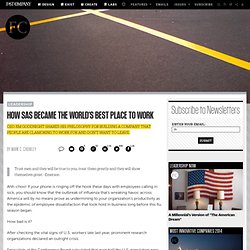

815db14a-0048-425e-969c-246930967d58-original.png (PNG Image, 1592 × 963 pixels) - Scaled (64%) Kotter International - The 8-Step Process for Leading Change. How SAS Became The World's Best Place To Work. Trust men and they will be true to you; treat them greatly and they will show themselves great.

--Emerson Ahh-choo! If your phone is ringing off the hook these days with employees calling in sick, you should know that the outbreak of influenza that’s wreaking havoc across America will by no means prove as undermining to your organization’s productivity as the epidemic of employee dissatisfaction that took hold in business long before this flu season began. How bad is it? After checking the vital signs of U.S. workers late last year, prominent research organizations declared an outright crisis. Specialists at the Conference Board calculated that over half the U.S. population now hates their job. What’s now fully understood is that traditional remedies to disengagement no longer are effective. The common prognosis now is that employee satisfaction and commitment cannot be restored to full health until leaders adopt more supportive management practices.
The question now is, how? 10 Principles of Change Management. Updated: 10 Principles of Leading Change Management This classic guide to organizational change management best practices has been updated for the current business environment.

To read the newest article, click here. Or, to watch a related video, click on the play button above. Way back when (pick your date), senior executives in large companies had a simple goal for themselves and their organizations: stability. Shareholders wanted little more than predictable earnings growth. Market transparency, labor mobility, global capital flows, and instantaneous communications have blown that comfortable scenario to smithereens.
This presents most senior executives with an unfamiliar challenge. Long-term structural transformation has four characteristics: scale (the change affects all or most of the organization), magnitude (it involves significant alterations of the status quo), duration (it lasts for months, if not years), and strategic importance. Sydney.edu.au/education_social_work/professional_learning/resources/papers/StanleyG_06_SustainableLeadership.pdf. Recognizing Organizational Culture in Managing Change. Structural changes can serve as the initial intervention for shifting culture.

By Mark Mallinger, PhD, Don Goodwin, MBA and Tetsuya O’Hara, MBA 2009 Volume 12 Issue 1 The dramatic increase in products, markets, enhanced technology, and robust competition has led to a dynamic global business environment. Companies that have flourished in the 21st century are those that have learned to respond to turbulence by managing change effectively.[1] Most organizations are aware of the need for change; however, the challenge lies in implementing strategies that stick.
For a number of reasons, including a lack of understanding of deeper organizational issues or a failure to recognize the cross-functional implications of change,[2] system-wide change often goes awry. Photo: Pinopic The purpose of this article is to examine how organizational culture influences the likelihood of success for change strategies, and to provide tools for the reader to apply within his or her organization.
Goodwin Company.